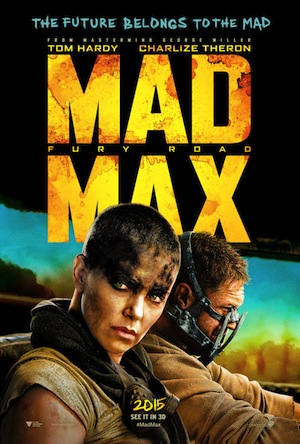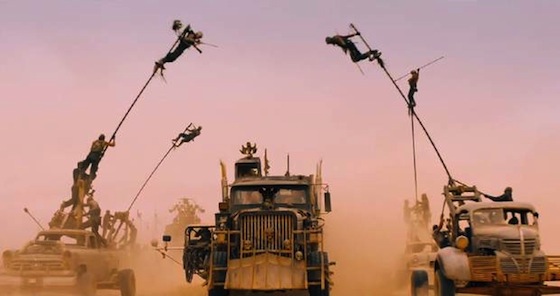This movie review appears originally at Lawrence.com.
A caravan of paint-sniffing albino “war boys” with sunken eyes and scars around their lips race down a dirt road in a post-apocalyptic desert wasteland.
Their souped-up vehicles are cobbled together in all kinds of inventive ways — some are antique car shells stacked up on each other under giant monster-truck tires; some have elaborate exhaust pipes that run the length of the cars and spit fire; other vehicles are covered in pointed sticks and spears that jut out like porcupines.
This cadre of crazies from Mad Max: Fury Road has a corollary to 70-year-old director George Miller: They are driven by a singular vision and purpose. Theirs is to find and kill the rogue warrior Imperator Furiosa (Charlize Theron) and bring back the harem she absconded with, and Miller’s is to present one nearly nonstop action scene with enough character and metaphorical connection to keep an audience engaged for two hours.
Boy, does he ever.
The first Mad Max movie in 30 years begins, oddly enough, with narration that ends up being the largest amount of uninterrupted dialogue in the entire film. It sets up the unforgiving landscape of these movies, and establishes the loner status of Max (Tom Hardy, in a role made famous by Mel Gibson).
In short order, Max is kidnapped and enslaved under the rule of Immortan Joe (Hugh Keays-Byrne, who also played the villain Toecutter in the 1979 original). This giant, mask-wielding freak hoards all of the water to be found in this vast desert, dispensing it to the lowly people of the Citadel only when it suits him.
Once Joe and his war boys set out on Fury Road to retrieve his sex slaves from Furiosa, our title character is sidelined for a good 30 minutes or so. Strapped to the front of a car like the figurehead at the tip of a ship’s hull, Max is helpless while chaos rages around him and Miller’s penchant for crazed black comedy again rears its head.
It’s a nice twist that the real hero of the movie is Theron’s Furiosa, whose shaven head and raw determination bring to mind Sigourney Weaver’s Ripley from the Alien series.
Mad Max: Fury Road all takes place in a short period of time, and very little backstory is presented for the characters. But their richness is revealed in how they react under constant duress. The movie may not seem like the work of an elder statesman, but Miller’s experience means he knows how to present not only the cause-and-effect of an action scene but also develop and refine his characters during the battle.
One such character is Nux (Nicholas Hoult), a cancer-ridden war boy who, like the rest of the minions, will do anything to please Joe and enter Valhalla. His blind fanaticism makes him sympathetic, and serves as a subtle but potent anti-terrorism metaphor.
When the five women of Joe’s harem are first glimpsed, it’s all long legs and bare midriffs — the typical hyper-sexualized image we are used to in Hollywood pictures. But that’s because the tyrannical despot is using them in that way. They become something quite different on their journey.
It’s no coincidence what their escape represents, or that the women are freed by a powerful woman who rebels against the male hierarchy. Besides having some interesting thematic and plot similarities to the recent Tommy Lee Jones-Hilary Swank western The Homesman, you might even be able to say Mad Max: Fury Road is a feminist film.
It certainly has connections to Miller’s criminally overlooked 1998 film Babe: Pig in the City, which also features impressive, large-scale action scenes and ingenious production design. Art director Colin Gibson worked on both films, and again creates a rich fantasy world with inspired choices in every frame.
The hard-charging convoy is like a junkyard on wheels. As obtuse and fantastical as the car designs are, these are real, working vehicles careening around at high speeds on rough terrain.
One mammoth vehicle actually holds a line of taiko drummers pounding out a primal beat behind a wall of amplifiers and speaker horns. To seal further comparisons to a Gwar-like aesthetic, a manic frontman attached with cables by the arms and legs plays heavy-metal electric guitar in front of them to rev up the troops. Oh, and did I mention the guitar is also a flamethrower? Ha!
The scene where Max has to tangle with this guy is one of the most hilarious and thrilling in the movie. And it’s somehow convincing — the CGI is so subtle throughout Mad Max: Fury Road that it blends seamlessly with the action.
Along with Gibson, stunt coordinator Guy Norris and cinematographer John Seale are the real stars of the film. Norris conducts breathless sequences where wild-eyed soldiers are launched from moving cars on towering poles that bend to and fro as they speed along. Seale pays tribute to Miller’s previous entries in the franchise with lightning-quick zooms and Sam Raimi Evil Dead-style POV shots, yet somehow still maintaining a sense of coherence.
Resurrecting Mad Max in 2015 might seem like an odd choice, but Miller’s kinetic vision of post-environmental doom seems more prescient than ever. And although Gibson gave Max more of a soul than Hardy does, Miller’s storytelling strategy of standalone micro-stories means that the character could continue beyond any one actor, similar to James Bond. The focus on action and not over-explaining things also keeps the “Mad Max” universe contextually relevant.
“Hope,” as Max tells Furiosa, “is a mistake.” But Mad Max: Fury Road represents a certain kind of hope that’s more than a little contagious. As technology continues to improve and digital effects persist, it’s refreshing to see an old-school master get back to basics — and use his powers for good.











Comments on this entry are closed.